candle lamp
Flashlight Enthusiast
Reviewer's note : Olight S10 (XM-L2) & S20 (XM-L2) were provided by Olight for review.
Olight has released the upgraded 2013 editions of the S10 & S20 which are Baton series, powered by 1x(R)CR123A and 1x18650 (or 2xCR123A) respectively.
.
.

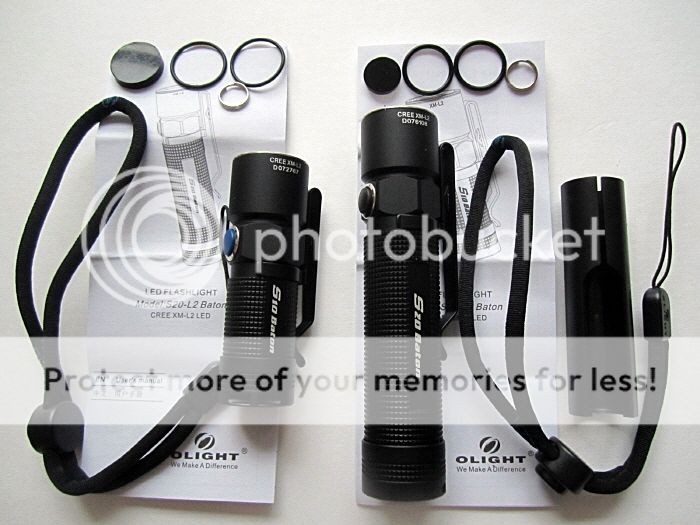
Both lights come with removable pocket clip (attached), spare o-rings, tailcap silicon pad, split ring, lanyard, user manual. (The manual is available for download on Olight website.)
.
.
Manufacturer Specifications from Olight's website and user manual :
1. Common Specifications
• Aviation grade aluminum body, with anti-scratch type III hard anodizing.
• Updated the LED to the latest Cree XM-L2.
• There are four brightness levels: Moon-light, low, middle and high. These levels can be memorized when the light turned off; one special mode: strobe.
• Under off status, single click will turn on the light, quick double clicking can get high brightness, triple-click enable strobe mode, while long time press enable moon light.
• With strong magnet in the end of tail, the flashlight can be stick on the iron surface. The magnet can be removed and replaced by users.
• Invertible U-shape embrace clip.
• Stainless steel head ring, which can bear higher tensile impaction
• Flat tail cap, can be easily head stood.
• Time based thermal management, after lighting on high mode for 4.5 minutes, the output ramps down to 50% of high brightness to avoid overheating.
• Waterproof: IPX8
• Impact resistance : 2m
• Special mode : Strobe 10Hz
2. S10 XM-L2
• S10 has high efficient synchronous boost-buck driver circuit, perfectly support CR123A & RCR123A battery.
• Output & running time : High (400lumens : 1hr 15min), Med. (85lumens : 7.5hr), Low (5lumens : 108hr), Moonlight (0.5lumens : 360hr)
• Beam distance : 104m
• Peak beam intensity : 2700cd
• Dimension : 70.5mm (Length) x 23mm (Dia.)
• Weight : 42g (without battery)
3. S20 XM-L2
• S20 is designed for a wide input voltage and both 2xCR123A and 1x18650 are available.
• Output & running time : High (550lumens : 2hr), Med. (120lumens : 9hr), Low (5lumens : 120hr), Moonlight (0.5lumens : 600hr)
• Beam distance : 118m
• Peak beam intensity : 3500cd
• Dimension : 106mm (Length) x 23mm (Dia.)
• Weight : 52g (without battery)
.
.
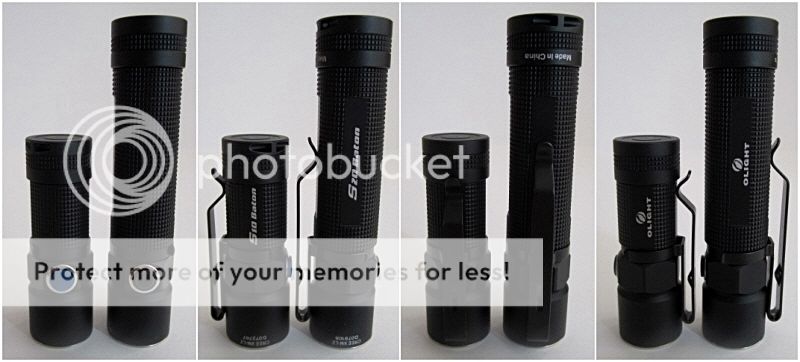
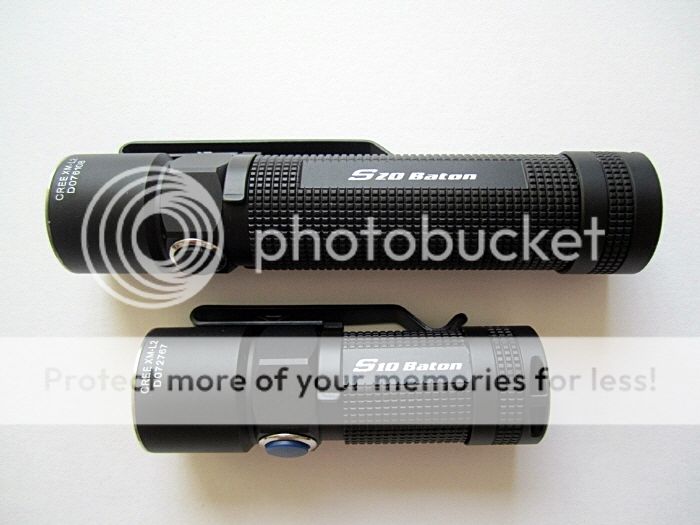
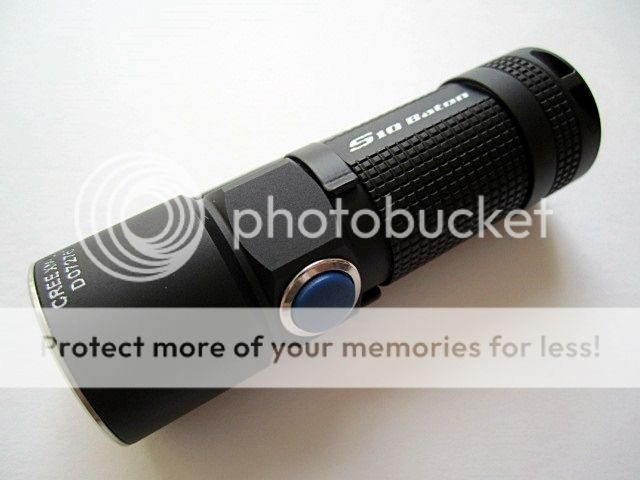
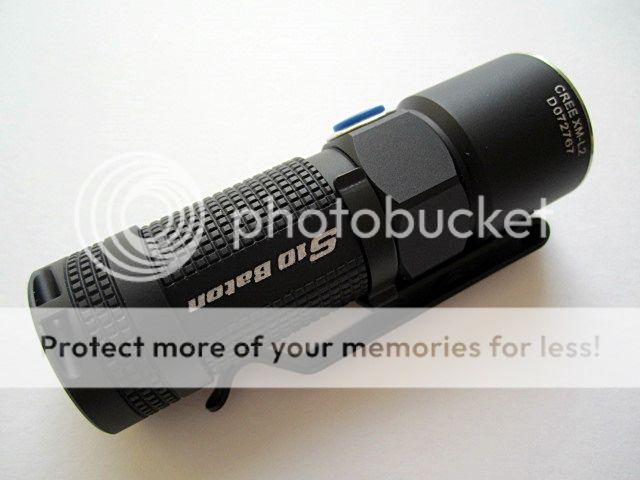
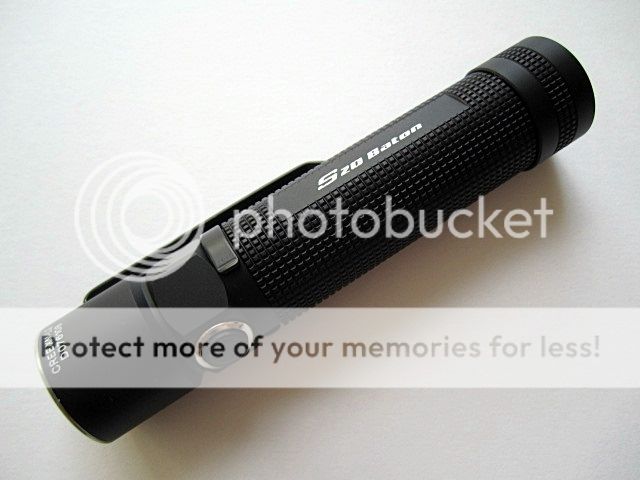
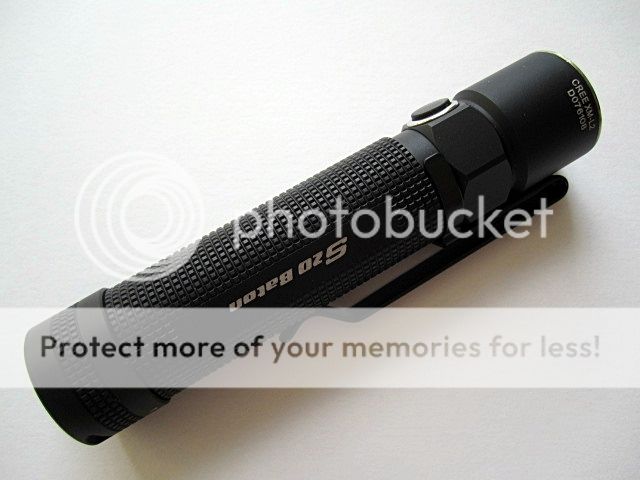
The S10 XM-L2 and S20 XM-L2 are quite small for each class. Overall build is very similar to the S15 XM-L2 I reviewed.
The hard(type III) anodizing is a matte black and no flaws on my samples. All labels are sharp and clear in bright white against the black background. The checkered pattern is present over most of the body. The light has no tail switch. Fit and finish looks very good.
.
.
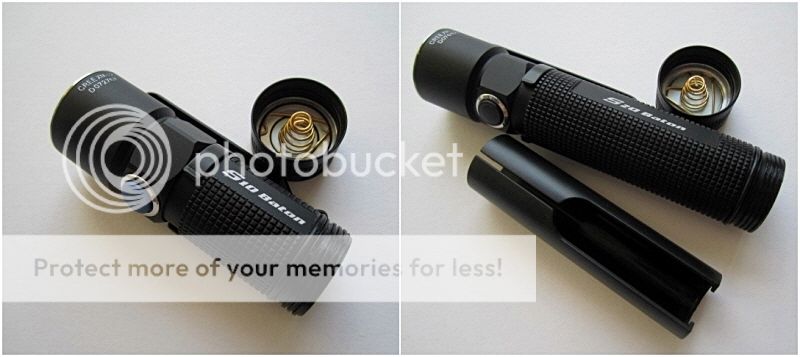
The light has 2 parts. The body is one piece with the head (i.e., the body has a built-in head). The pocket clip works as a good anti-roll device.
.
.

The light has a flat stainless steel bezel ring and a red o-ring. The head has a clean looking cylindrical design with a hex-shaped neck which provides grip. There's an electronic side button switch on the hex-shaped neck. The side button switch is hard plastic, and it has a good feel to touch and has short travel, which produces a quiet clicking sound. S10 does produce more quiet clicking sound than S20.
.
.
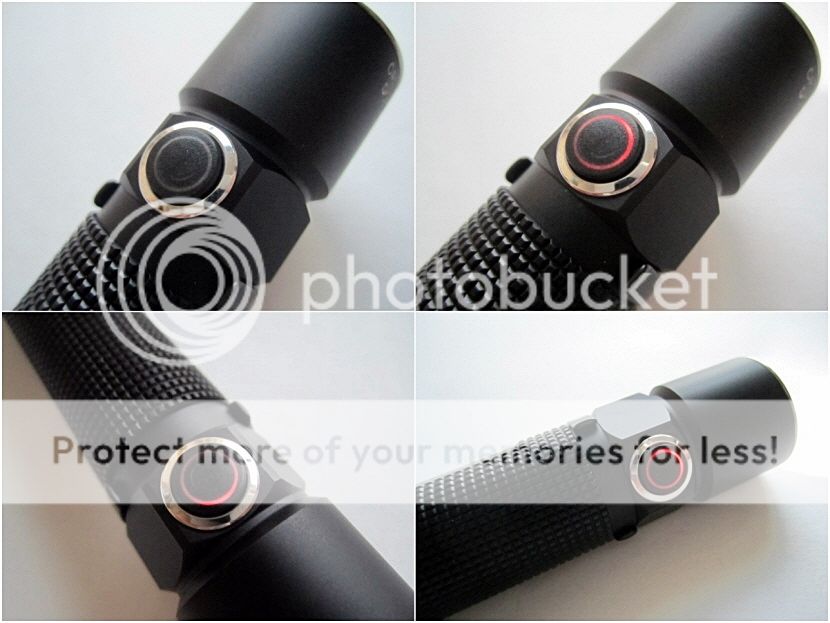
On the S20 XM-L2, the side button switch will show red as the battery is near exhaustion (i.e., the S20 has low warning voltage feature). But there's no low-voltage warning feature on the S10 XM-L2.
.
.
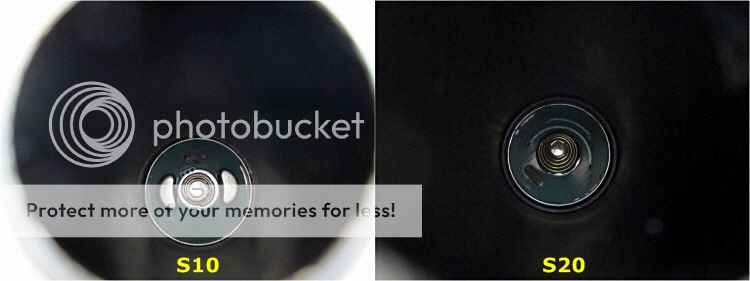
In the S10 XM-L2, the positive battery contact has two semicircular raised lips which work as a mechanical (or physical) reverse polarity protection similar to S15 XM-L2.
In the S20 XM-L2, the positive battery contact has a spring. So flat-top cells work just fine in the lights. The light has reverse polarity protection to protect from incorrect battery installation (i.e., the electronics of the S20 XM-L2 has in-built reverse polarity protection.
.
.
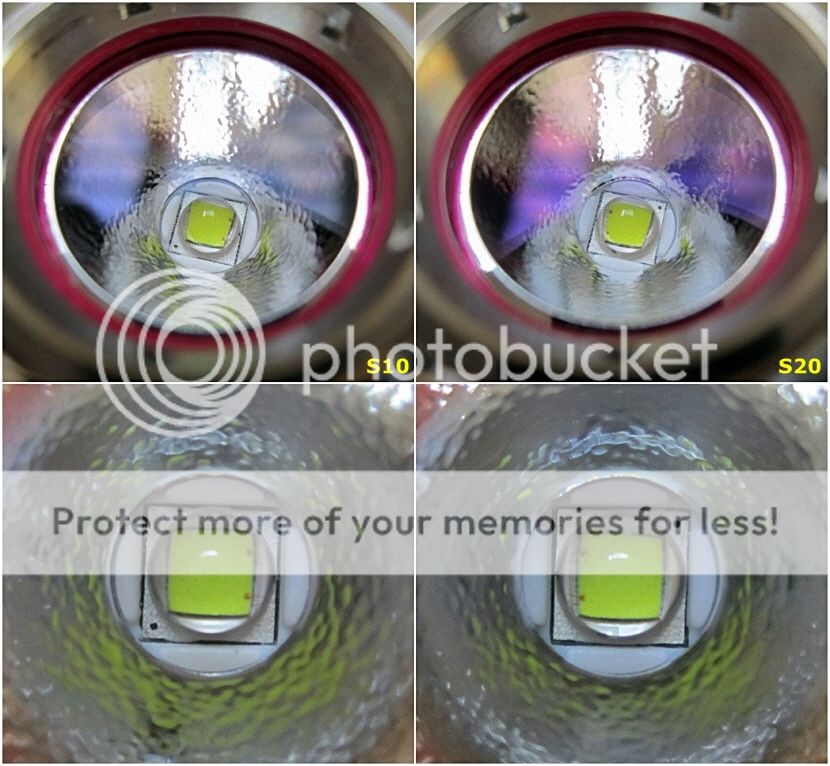
The light orange peel reflectors of both lights seem to be the quite same in size, and the reflectors are not deep. So I expect a wide spill beam. The lights use AR coating lens. The sky blue hue and the purple hue is reflected on the S10 XM-L2 and S20 XM-L2 lens respectively. The reflectors are well polished with no noticeable finishing flaws and well-centered XM-L2 LED sits at the bottom of the reflector cup.
.
.
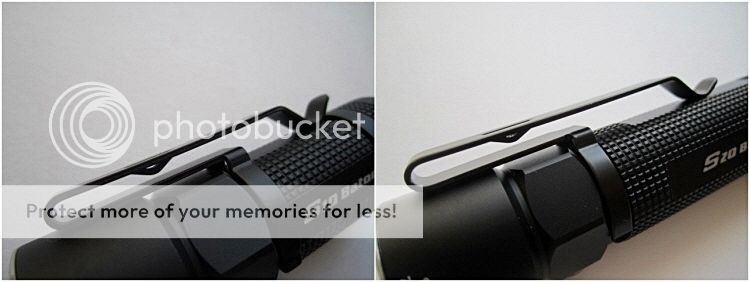
The pocket clip looks sturdy and hold onto the light very securely. It is reversible, allowing both bezel-up or bezel-down.
.
.
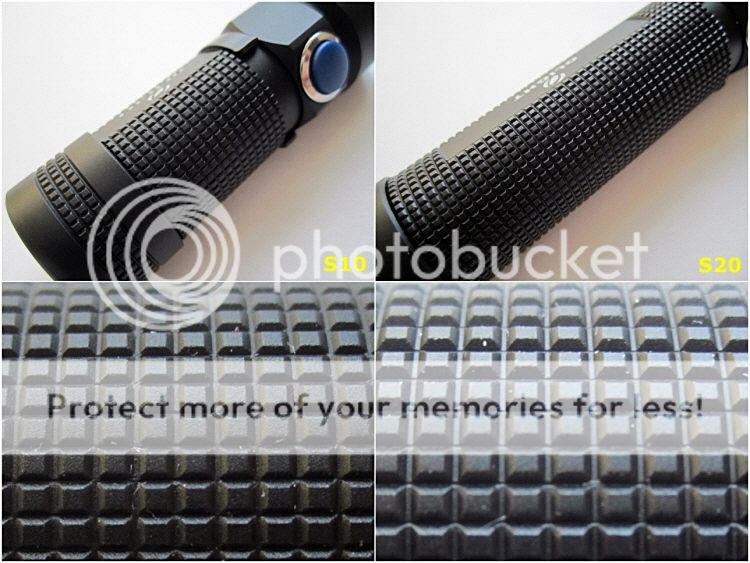
The battery tube (i.e., body) is mostly covered in a bold checkered portions with two flat faces where manufacturer & model name are printed on, and the other flat face where the clip is touching. With the pocket clip attached, grip is good.
The wall thickness of the body is 1.76mm and 1.49mm for the S10 and S20 respectively. The light feel solid.
.
.
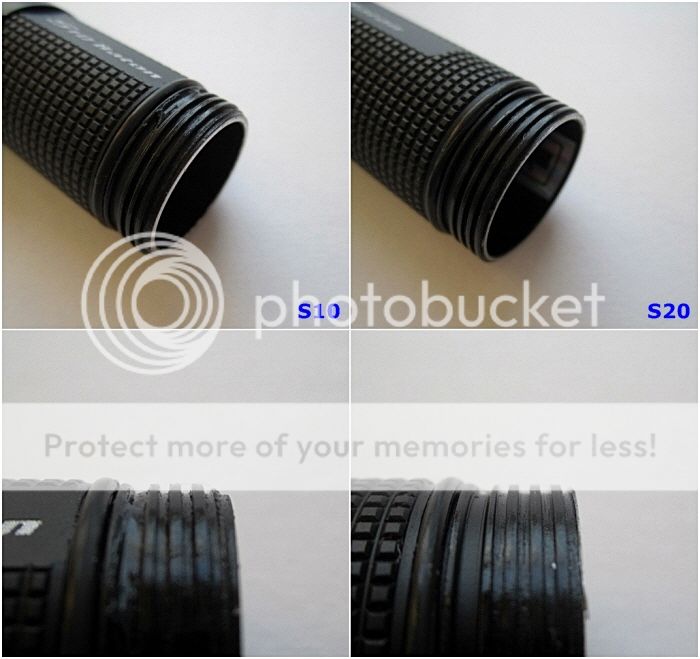
The screw threads are square-cut of good quality. Threads are well machined, and anodized which allows the light to be locked-out when the tailcap is slightly loosened. As supplied, threads are well lubricated. Screw threads action is smooth with no cross-threading or squeaking on my samples.
.
.
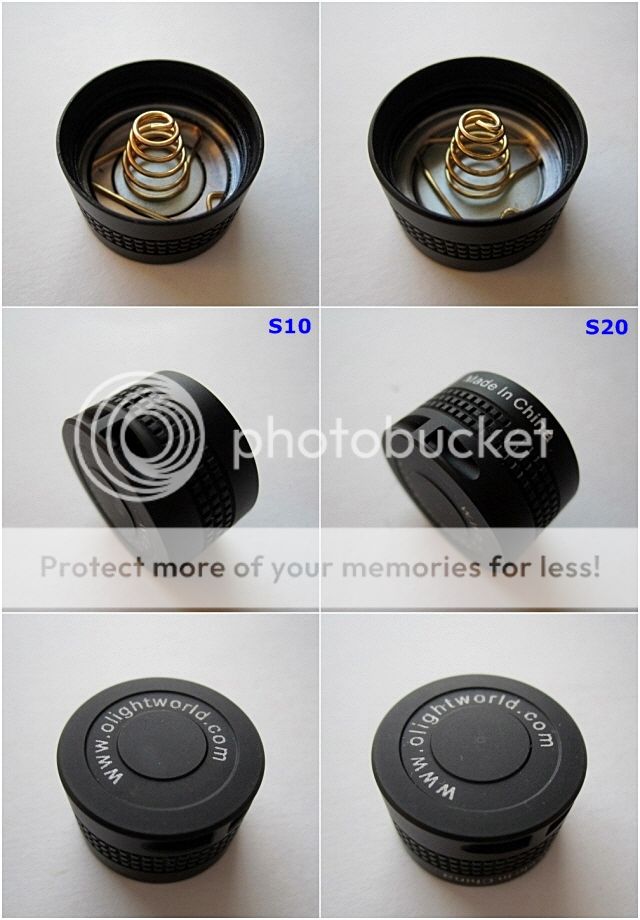
Like the S15 XM-L2, there is a removable negative spring come with a removable strong magnet on the inside of the tailcap. There is small hole on the tail side for lanyard or split ring attachment. The magnet pull is fairly strong, so it does pick up the battery through the negative spring, because the spring and the magnet are actually in contact. The light sticks to all the metal objects made with steel. If you don't want the magnet, you can replace it with the silicone pad come with the light (i.e., you can take out the magnet by releasing the spring holding the magnet in place by prising the three edges of the spring out from under the recess on the tailcap).
.
.
User Interface
The S10 XM-L2 and S20 XM-L2 have the quite same UI.
There are two modes (i.e., general mode & strobe mode).
1) General mode
Output switching is controlled by the electronic side switch. A quick press and release turns the light on, and another quick press and release turns the light off.
When on, holding down the switch will proceed Low -> Med. -> High, in repeating sequence. To select your desired mode or output level, just release the switch. The light has mode memory, and remembers the last output level used when you turn the light off and back on. Unlike the S15 XM-L2, the light doesn't remember the last output after a battery change.
You can access Moonlight (or firefly mode) directly from "Off" only by a sustained press of the switch for one second. This means Moonlight is a completely separate mode from the above Low - Med. - High.
Double quick click from Off will activate High directly.
If you hold the switch down from Off for more than two seconds, the light is locked-out (Olight says it's a Lock). You can't use the light until you unlock it by pressing and holding the switch for more than one second (i.e., another holding down the switch for one second will activate Moonlight). Also you can twist the tailcap slightly for lock-out as well.
2) Strobe mode
The "hidden" Strobe is accessed by double-clicking the switch when on. A single sustained press of the switch (or double-clicking the switch) will return to the previous output level in general mode. The strobe has no memory.
.
.
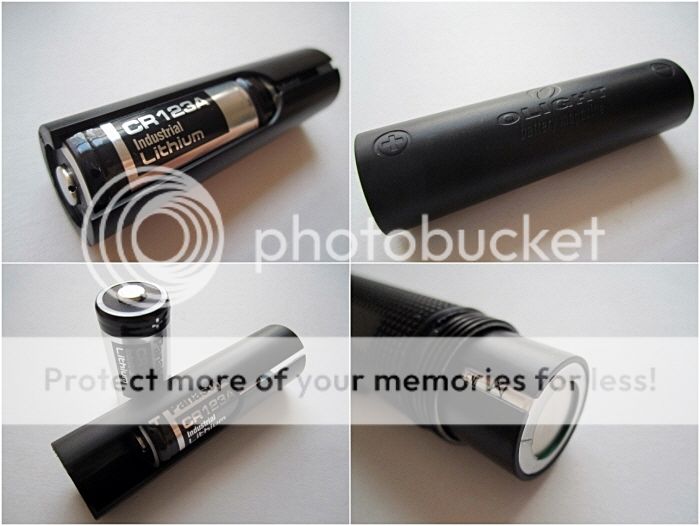
The included 2xCR123A battery magazine in the S20 XM-L2 is optional, and it certainly removes battery rattle in case of using it.
.
.
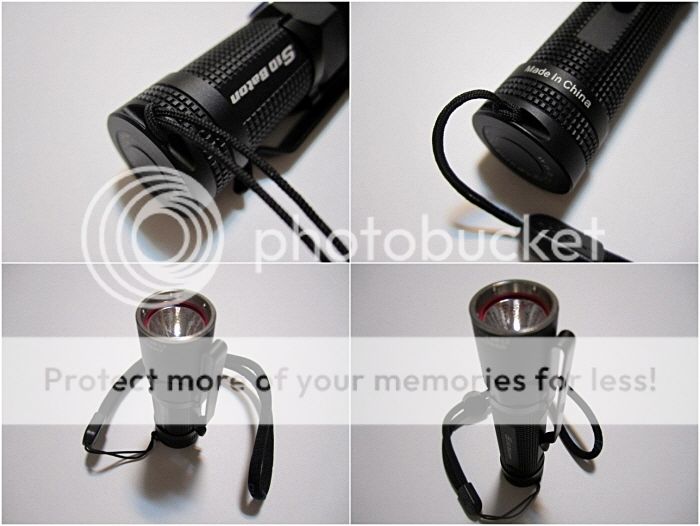
The lanyard quality is as good as high build quality of the light. The S10 XM-L2 and S20 XM-L2 can tailstand stably.
.
.
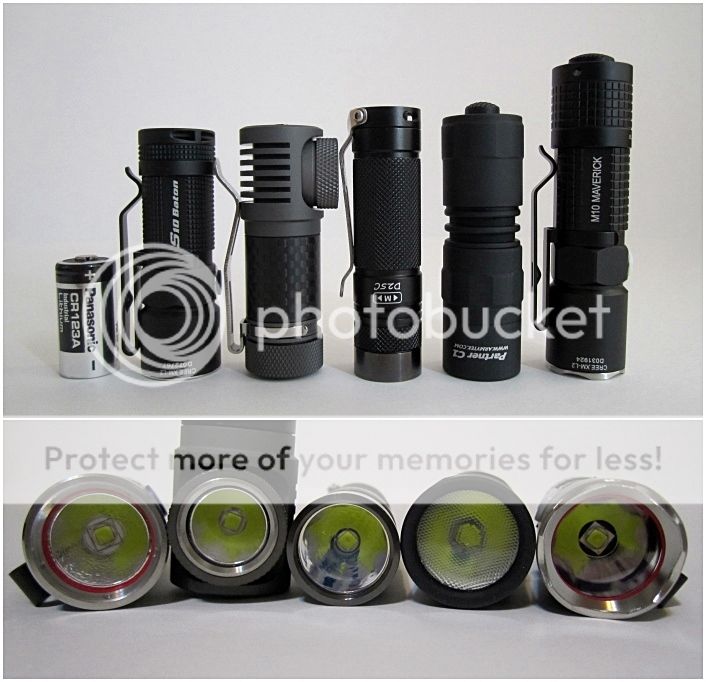
From left to right, Panasonic CR123A, Olight S10 XM-L2, Spark SG3, Eagletac D25C, Armytek Partner A1, Olight M10 Maverick.
The head size & light weight excluding battery of five lights are as follows :
S10 XM-L2 - 23.1mm / 42g, SG3 - 24mm / 41g, D25C - 20.0mm / 76g, Partner A1 - 24.0mm / 56g, M10 Maverick - 23.0mm / 54g
.
.
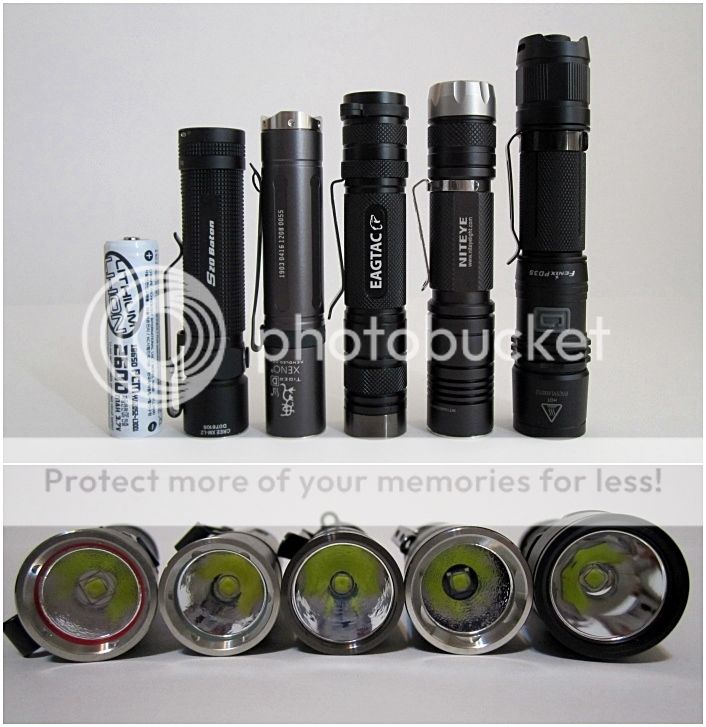
From left to right, VicLite 18650, Olight S20 XM-L2, Xeno S3A, Eagletac D25LC2, Niteye MSC20, Fenix PD35.
The head size & light weight excluding battery of five lights are as follows :
S20 XM-L2 - 23.0mm / 52g, S3A - 21.5mm / 52g, D25LC2 - 22.6mm / 51g, MSC20 - 23.80mm / 75g, PD35 - 25.4mm / 87g
.
.
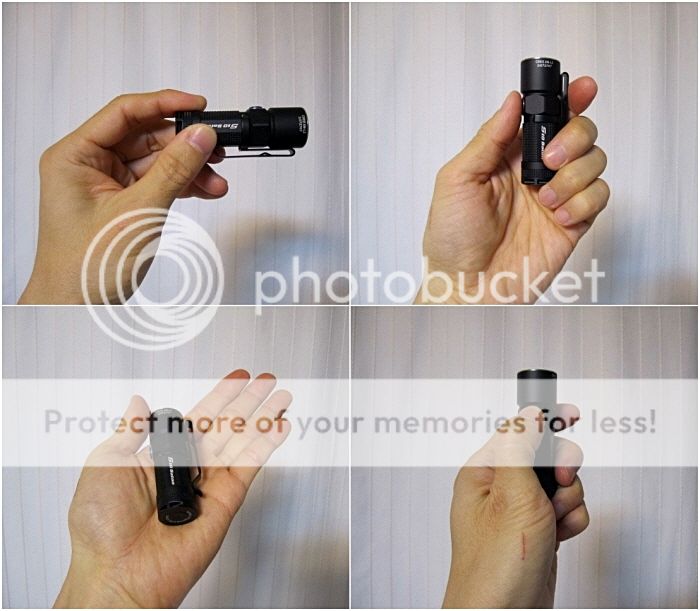
- S10 XM-L2
.
.
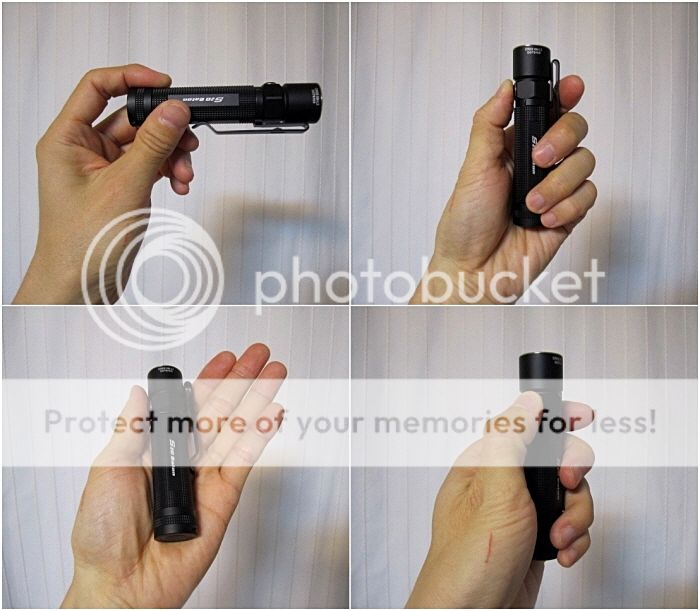
- S20 XM-L2
It is good size to hold and use. It can be used as an EDC light. Overall build quality of both lights is very high.
.
.
Measured Dimensions
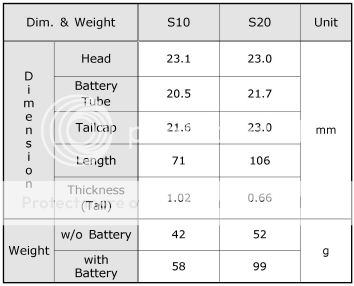
.
.
Standby Current Drain
Due to the electronic side switch interface, the S10 XM-L2 and S20 XM-L2 are drawing a small current when the light is fully connected. I measured this current as 6.1μA for S10 and 27μA for S20.
For 1xCR123A (1400mAh) cell, that would translate into around 26 years before it would be fully drained. For 1x18650 (2600mAh) cell, that would translate into around 11 years before it would be fully drained. These are negligible, not a concern. But I would recommend you to store the light locked-out when not in use for a long time or to prevent accidential activation.
.
.
PWM
1. S10 XM-L2
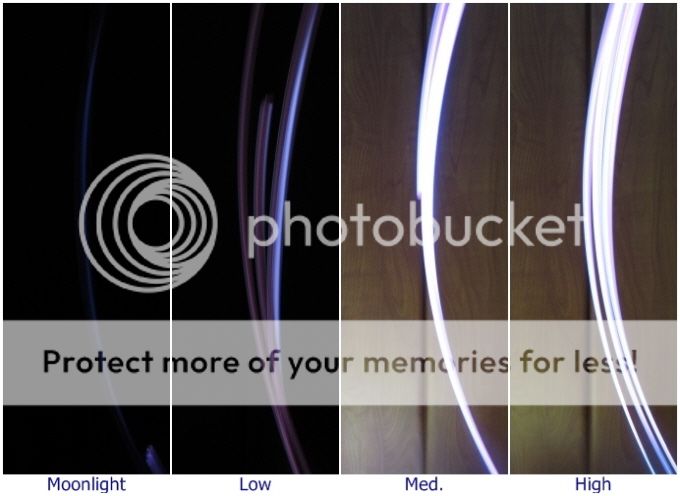
The S10 XM-L2 shows no sign of PWM at all output levels. I notice there is no buzzing sound at any levels.
.
.
2. S20 XM-L2

The light shows no sign of PWM at all output levels. I notice there is no buzzing sound at any levels too.
.
.
Runtime
The runtime on High to fall to 10% of its initial output from 30 seconds after the point the light is first turned on (i.e., based on ANSI FL-1) for High is as follows :
1. S10 XM-L2
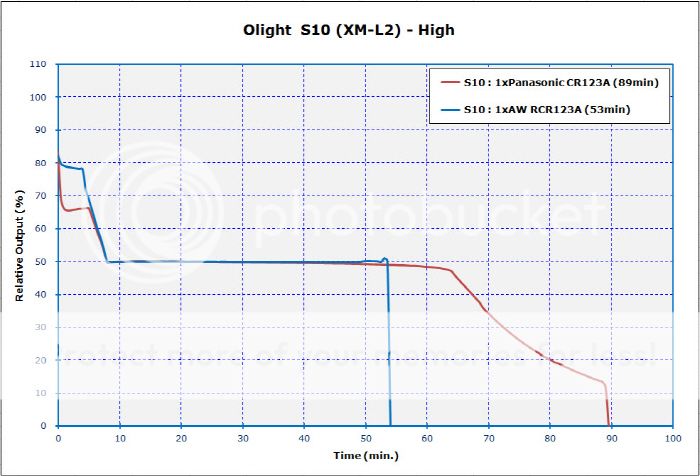
1) 1xPanasonic CR123A : 89min (1hr 29min)
2) 1xAW RCR123A : 53min (0.9hr)
S10 XM-L2 starts to step down gradually on High after around 4 mins runtime, and level off to 60% of the initial output after 8 mins on both 1xCR123A and 1xRCR123A. This seems to be a timed drop-down, not a thermal sensor feature.
The Hight on CR123A does drop much more rapidly than RCR123A. But runtime on CR123A has relatively longer than RCR123A as expected. The light is very well regulated on RCR123A.
2. S20 XM-L2
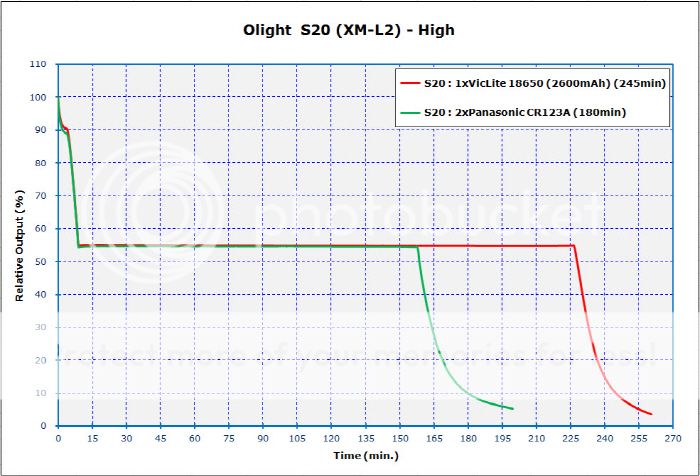
1) 1xVicLite (2600mAh) : 245min (4hr 5min)
2) 2xCR123A : 180min (3hr)
S20 XM-L2 starts to step down gradually on High after around 4 mins runtime, and level off to 55% of the initial output after 9 mins on both 1x18650 and 2xCR123A.
This seems to be a timed drop-down, not a thermal sensor feature. Regulation is maintained very nicely through High on all batteries.
.
.
3. S10 XM-L2 and S20 XM-L2
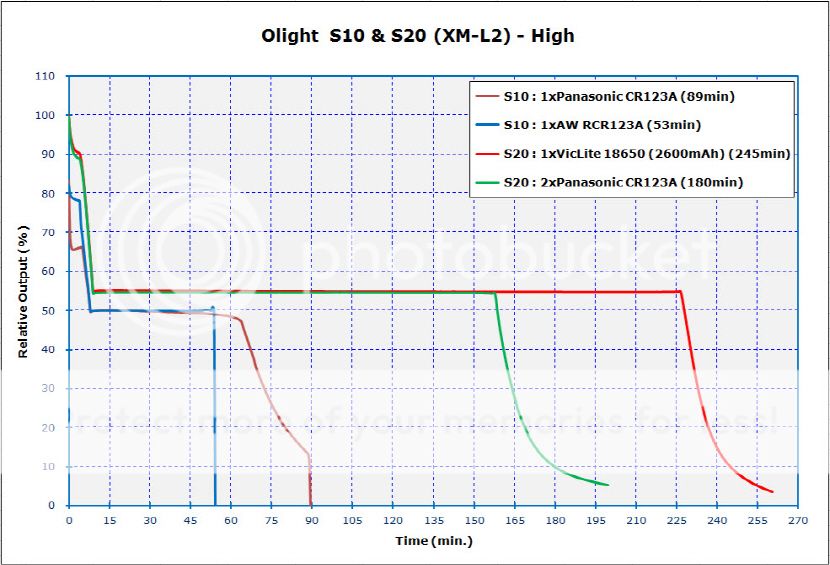
.
.
Beamshot
1. White door beamshot (about 50cm from the white door) on Max. output
1-1. S10 XM-L2
- ISO100, F/3.5, 1/250sec, Auto white balance
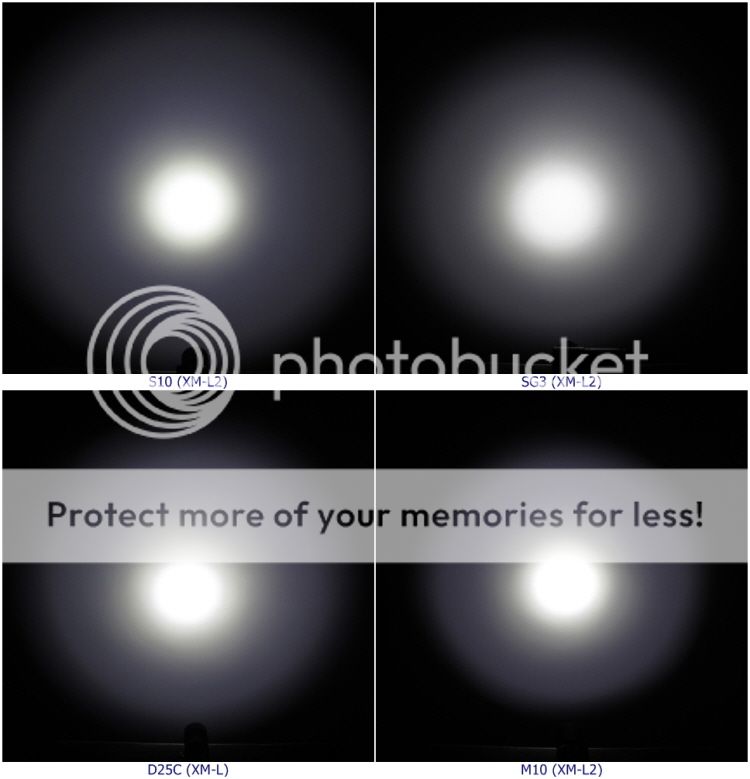
.
.
- ISO100, F/3.5, 1/500sec, Auto white balance

.
.
- ISO100, F/3.5, 1/800sec, Auto white balance
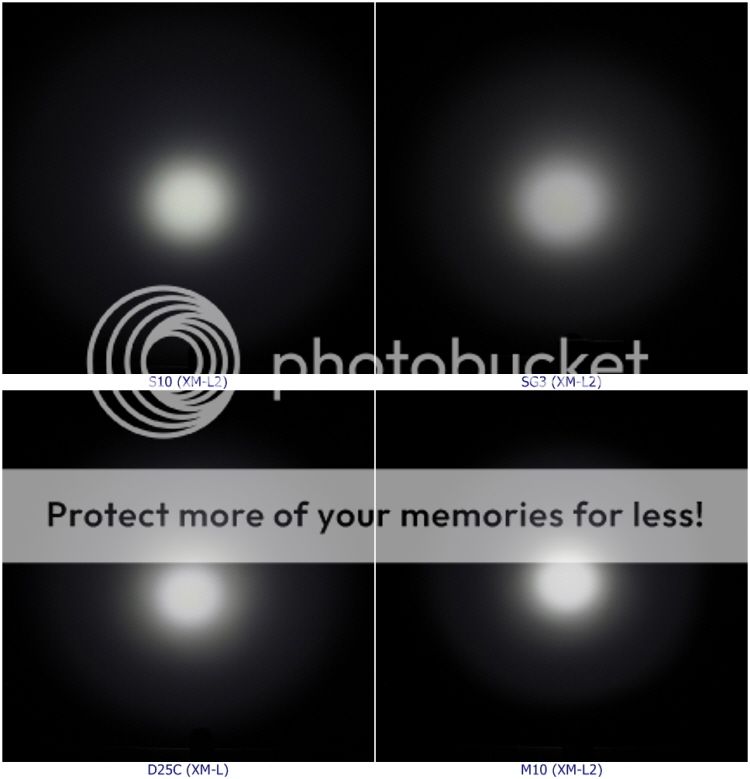
The medium sized hotspot is well focused and its tint is slightly towards the very light green hue on my sample. A soft corona surrounds the bright hotspot. The spill beam is relatively large compared to the other lights, and clean with no artifacts. The overall beam profile is good. The beam has a typical cool tint.
.
.
1-2. S20 XM-L2
- ISO100, F/3.5, 1/400sec, Auto white balance

.
.
- ISO100, F/3.5, 1/800sec, Auto white balance
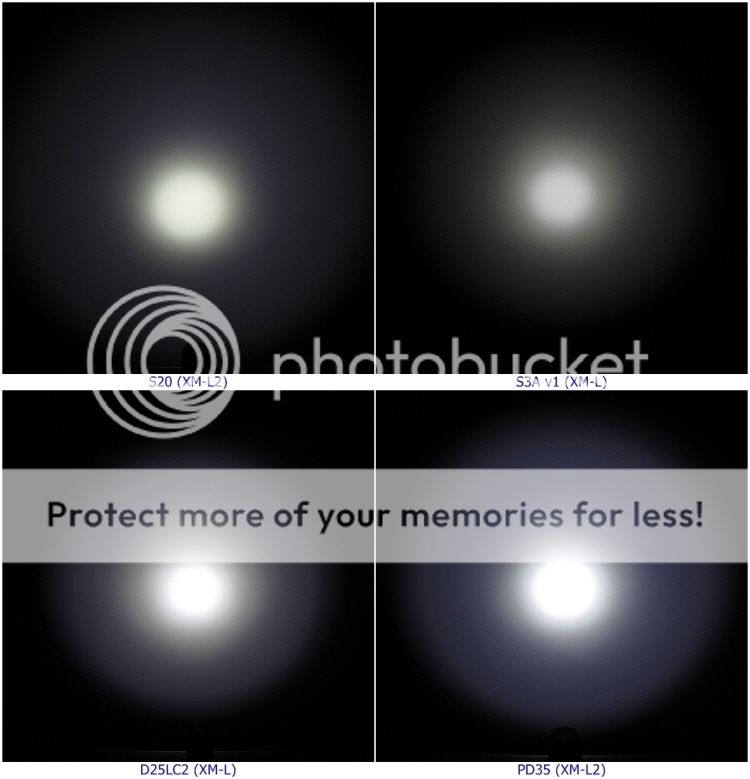
.
.
- ISO100, F/3.5, 1/1250sec, Auto white balance
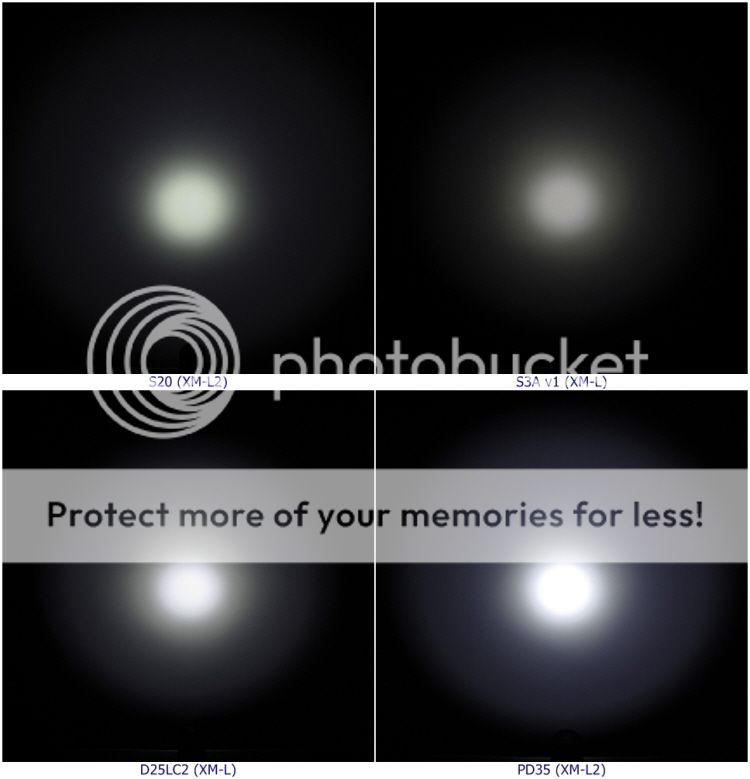
The medium sized hotspot is well focused and its tint is slightly towards the very light green hue on my sample. A soft corona surrounds the bright hotspot. The spill beam is relatively large compared to the other lights, and clean with no artifacts. The overall beam profile is good. The beam has a typical cool tint.
.
.
2. Indoor beamshot (about 7.0m from the target) on Max. output
2-1. S10 XM-L2
- ISO100, F/2.8, 1/2sec, Auto white balance

- Control shot
.
.
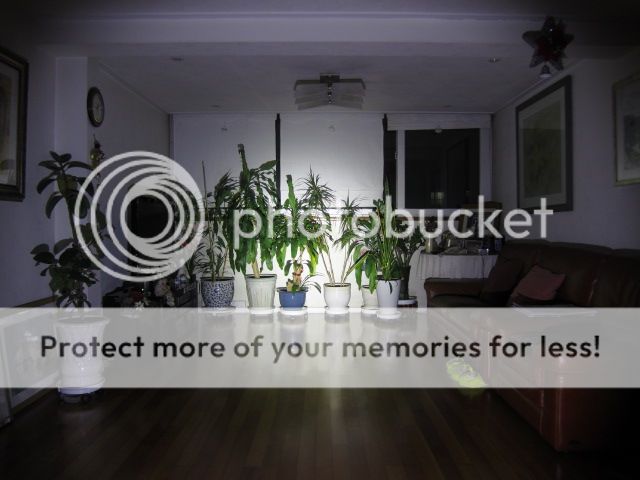
- S10 XM-L2
.
.
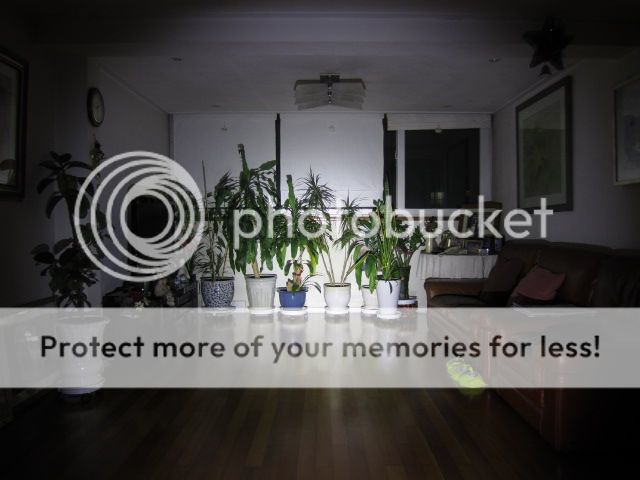
- SG3
.
.
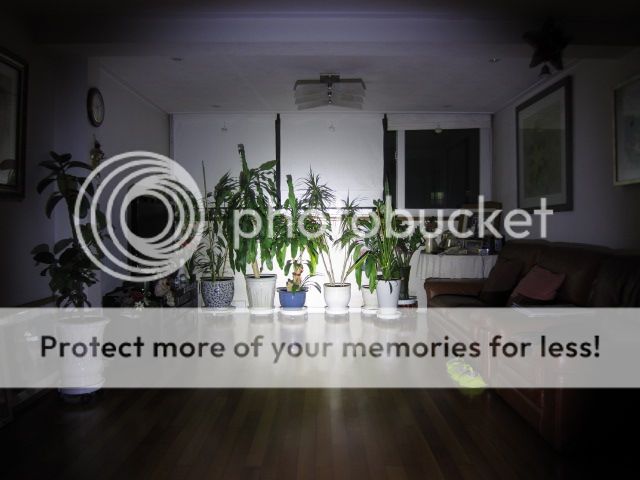
- D25C
.
.
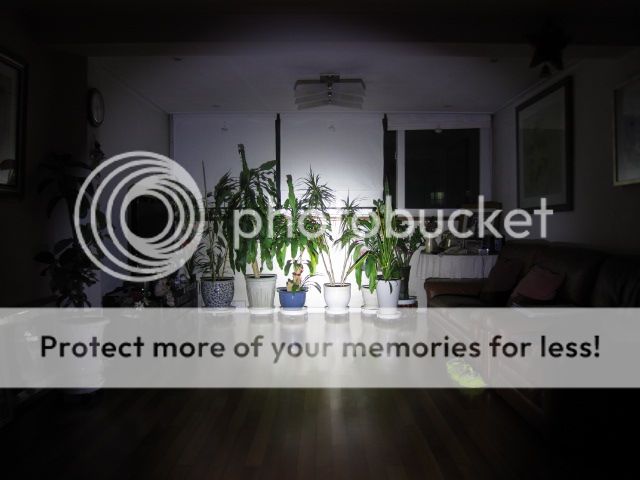
- M10
.
.
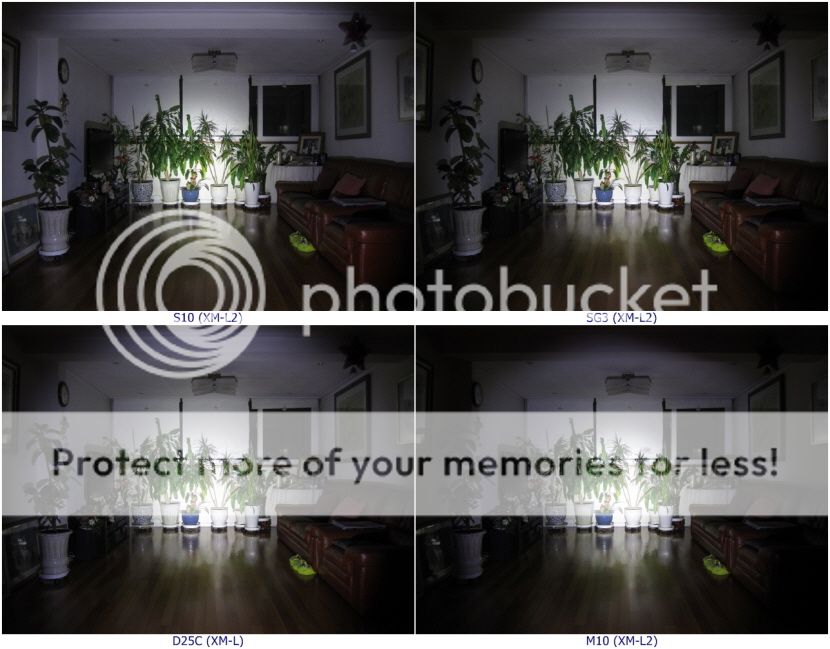
.
.
2-2. S20 XM-L2
- ISO100, F/2.8, 1/2sec, Auto white balance

- Control shot
.
.
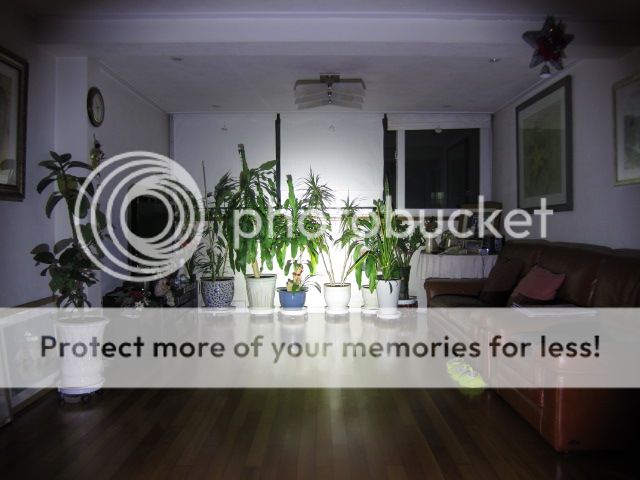
- S20 XM-L2
.
.
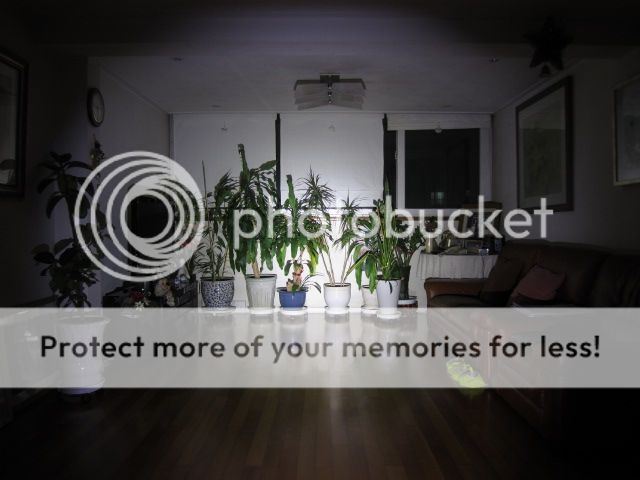
- S3A v1
.
.

- D25LC2
.
.
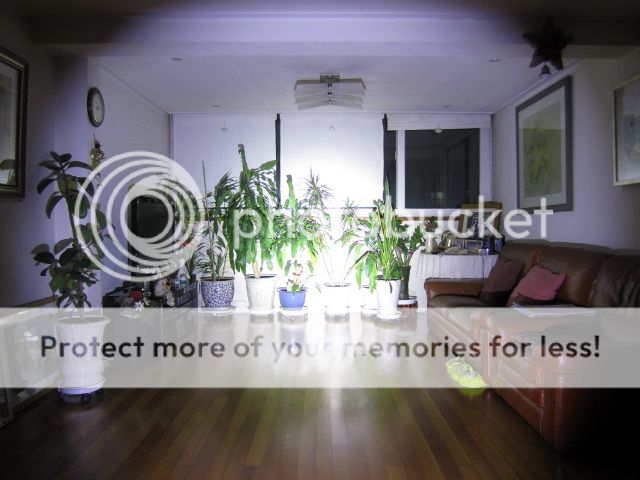
- PD35
.
.
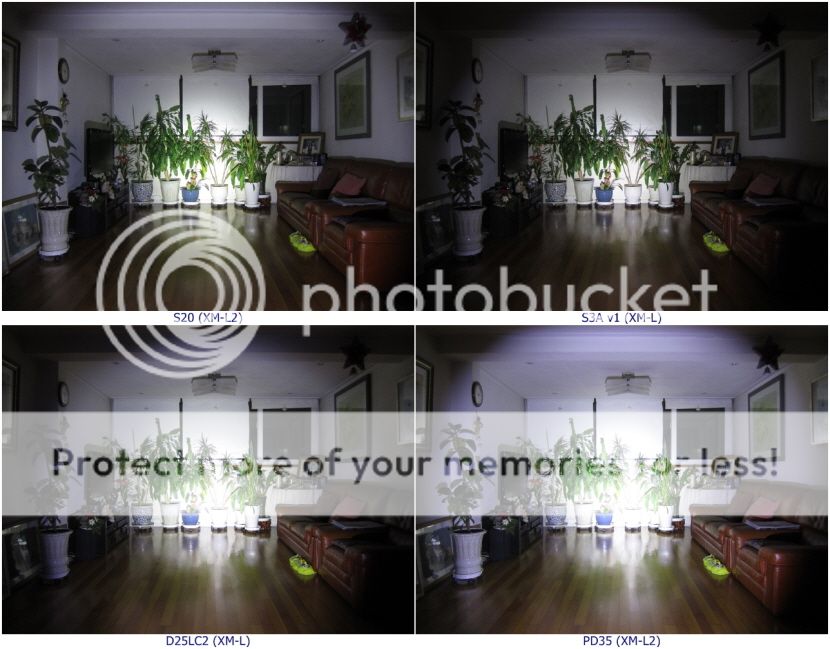
Olight has released the upgraded 2013 editions of the S10 & S20 which are Baton series, powered by 1x(R)CR123A and 1x18650 (or 2xCR123A) respectively.
.
.


Both lights come with removable pocket clip (attached), spare o-rings, tailcap silicon pad, split ring, lanyard, user manual. (The manual is available for download on Olight website.)
.
.
Manufacturer Specifications from Olight's website and user manual :
1. Common Specifications
• Aviation grade aluminum body, with anti-scratch type III hard anodizing.
• Updated the LED to the latest Cree XM-L2.
• There are four brightness levels: Moon-light, low, middle and high. These levels can be memorized when the light turned off; one special mode: strobe.
• Under off status, single click will turn on the light, quick double clicking can get high brightness, triple-click enable strobe mode, while long time press enable moon light.
• With strong magnet in the end of tail, the flashlight can be stick on the iron surface. The magnet can be removed and replaced by users.
• Invertible U-shape embrace clip.
• Stainless steel head ring, which can bear higher tensile impaction
• Flat tail cap, can be easily head stood.
• Time based thermal management, after lighting on high mode for 4.5 minutes, the output ramps down to 50% of high brightness to avoid overheating.
• Waterproof: IPX8
• Impact resistance : 2m
• Special mode : Strobe 10Hz
2. S10 XM-L2
• S10 has high efficient synchronous boost-buck driver circuit, perfectly support CR123A & RCR123A battery.
• Output & running time : High (400lumens : 1hr 15min), Med. (85lumens : 7.5hr), Low (5lumens : 108hr), Moonlight (0.5lumens : 360hr)
• Beam distance : 104m
• Peak beam intensity : 2700cd
• Dimension : 70.5mm (Length) x 23mm (Dia.)
• Weight : 42g (without battery)
3. S20 XM-L2
• S20 is designed for a wide input voltage and both 2xCR123A and 1x18650 are available.
• Output & running time : High (550lumens : 2hr), Med. (120lumens : 9hr), Low (5lumens : 120hr), Moonlight (0.5lumens : 600hr)
• Beam distance : 118m
• Peak beam intensity : 3500cd
• Dimension : 106mm (Length) x 23mm (Dia.)
• Weight : 52g (without battery)
.
.






The S10 XM-L2 and S20 XM-L2 are quite small for each class. Overall build is very similar to the S15 XM-L2 I reviewed.
The hard(type III) anodizing is a matte black and no flaws on my samples. All labels are sharp and clear in bright white against the black background. The checkered pattern is present over most of the body. The light has no tail switch. Fit and finish looks very good.
.
.

The light has 2 parts. The body is one piece with the head (i.e., the body has a built-in head). The pocket clip works as a good anti-roll device.
.
.

The light has a flat stainless steel bezel ring and a red o-ring. The head has a clean looking cylindrical design with a hex-shaped neck which provides grip. There's an electronic side button switch on the hex-shaped neck. The side button switch is hard plastic, and it has a good feel to touch and has short travel, which produces a quiet clicking sound. S10 does produce more quiet clicking sound than S20.
.
.

On the S20 XM-L2, the side button switch will show red as the battery is near exhaustion (i.e., the S20 has low warning voltage feature). But there's no low-voltage warning feature on the S10 XM-L2.
.
.

In the S10 XM-L2, the positive battery contact has two semicircular raised lips which work as a mechanical (or physical) reverse polarity protection similar to S15 XM-L2.
In the S20 XM-L2, the positive battery contact has a spring. So flat-top cells work just fine in the lights. The light has reverse polarity protection to protect from incorrect battery installation (i.e., the electronics of the S20 XM-L2 has in-built reverse polarity protection.
.
.

The light orange peel reflectors of both lights seem to be the quite same in size, and the reflectors are not deep. So I expect a wide spill beam. The lights use AR coating lens. The sky blue hue and the purple hue is reflected on the S10 XM-L2 and S20 XM-L2 lens respectively. The reflectors are well polished with no noticeable finishing flaws and well-centered XM-L2 LED sits at the bottom of the reflector cup.
.
.

The pocket clip looks sturdy and hold onto the light very securely. It is reversible, allowing both bezel-up or bezel-down.
.
.

The battery tube (i.e., body) is mostly covered in a bold checkered portions with two flat faces where manufacturer & model name are printed on, and the other flat face where the clip is touching. With the pocket clip attached, grip is good.
The wall thickness of the body is 1.76mm and 1.49mm for the S10 and S20 respectively. The light feel solid.
.
.

The screw threads are square-cut of good quality. Threads are well machined, and anodized which allows the light to be locked-out when the tailcap is slightly loosened. As supplied, threads are well lubricated. Screw threads action is smooth with no cross-threading or squeaking on my samples.
.
.

Like the S15 XM-L2, there is a removable negative spring come with a removable strong magnet on the inside of the tailcap. There is small hole on the tail side for lanyard or split ring attachment. The magnet pull is fairly strong, so it does pick up the battery through the negative spring, because the spring and the magnet are actually in contact. The light sticks to all the metal objects made with steel. If you don't want the magnet, you can replace it with the silicone pad come with the light (i.e., you can take out the magnet by releasing the spring holding the magnet in place by prising the three edges of the spring out from under the recess on the tailcap).
.
.
User Interface
The S10 XM-L2 and S20 XM-L2 have the quite same UI.
There are two modes (i.e., general mode & strobe mode).
1) General mode
Output switching is controlled by the electronic side switch. A quick press and release turns the light on, and another quick press and release turns the light off.
When on, holding down the switch will proceed Low -> Med. -> High, in repeating sequence. To select your desired mode or output level, just release the switch. The light has mode memory, and remembers the last output level used when you turn the light off and back on. Unlike the S15 XM-L2, the light doesn't remember the last output after a battery change.
You can access Moonlight (or firefly mode) directly from "Off" only by a sustained press of the switch for one second. This means Moonlight is a completely separate mode from the above Low - Med. - High.
Double quick click from Off will activate High directly.
If you hold the switch down from Off for more than two seconds, the light is locked-out (Olight says it's a Lock). You can't use the light until you unlock it by pressing and holding the switch for more than one second (i.e., another holding down the switch for one second will activate Moonlight). Also you can twist the tailcap slightly for lock-out as well.
2) Strobe mode
The "hidden" Strobe is accessed by double-clicking the switch when on. A single sustained press of the switch (or double-clicking the switch) will return to the previous output level in general mode. The strobe has no memory.
.
.

The included 2xCR123A battery magazine in the S20 XM-L2 is optional, and it certainly removes battery rattle in case of using it.
.
.

The lanyard quality is as good as high build quality of the light. The S10 XM-L2 and S20 XM-L2 can tailstand stably.
.
.

From left to right, Panasonic CR123A, Olight S10 XM-L2, Spark SG3, Eagletac D25C, Armytek Partner A1, Olight M10 Maverick.
The head size & light weight excluding battery of five lights are as follows :
S10 XM-L2 - 23.1mm / 42g, SG3 - 24mm / 41g, D25C - 20.0mm / 76g, Partner A1 - 24.0mm / 56g, M10 Maverick - 23.0mm / 54g
.
.

From left to right, VicLite 18650, Olight S20 XM-L2, Xeno S3A, Eagletac D25LC2, Niteye MSC20, Fenix PD35.
The head size & light weight excluding battery of five lights are as follows :
S20 XM-L2 - 23.0mm / 52g, S3A - 21.5mm / 52g, D25LC2 - 22.6mm / 51g, MSC20 - 23.80mm / 75g, PD35 - 25.4mm / 87g
.
.

- S10 XM-L2
.
.

- S20 XM-L2
It is good size to hold and use. It can be used as an EDC light. Overall build quality of both lights is very high.
.
.
Measured Dimensions

.
.
Standby Current Drain
Due to the electronic side switch interface, the S10 XM-L2 and S20 XM-L2 are drawing a small current when the light is fully connected. I measured this current as 6.1μA for S10 and 27μA for S20.
For 1xCR123A (1400mAh) cell, that would translate into around 26 years before it would be fully drained. For 1x18650 (2600mAh) cell, that would translate into around 11 years before it would be fully drained. These are negligible, not a concern. But I would recommend you to store the light locked-out when not in use for a long time or to prevent accidential activation.
.
.
PWM
1. S10 XM-L2

The S10 XM-L2 shows no sign of PWM at all output levels. I notice there is no buzzing sound at any levels.
.
.
2. S20 XM-L2

The light shows no sign of PWM at all output levels. I notice there is no buzzing sound at any levels too.
.
.
Runtime
The runtime on High to fall to 10% of its initial output from 30 seconds after the point the light is first turned on (i.e., based on ANSI FL-1) for High is as follows :
1. S10 XM-L2

1) 1xPanasonic CR123A : 89min (1hr 29min)
2) 1xAW RCR123A : 53min (0.9hr)
S10 XM-L2 starts to step down gradually on High after around 4 mins runtime, and level off to 60% of the initial output after 8 mins on both 1xCR123A and 1xRCR123A. This seems to be a timed drop-down, not a thermal sensor feature.
The Hight on CR123A does drop much more rapidly than RCR123A. But runtime on CR123A has relatively longer than RCR123A as expected. The light is very well regulated on RCR123A.
2. S20 XM-L2

1) 1xVicLite (2600mAh) : 245min (4hr 5min)
2) 2xCR123A : 180min (3hr)
S20 XM-L2 starts to step down gradually on High after around 4 mins runtime, and level off to 55% of the initial output after 9 mins on both 1x18650 and 2xCR123A.
This seems to be a timed drop-down, not a thermal sensor feature. Regulation is maintained very nicely through High on all batteries.
.
.
3. S10 XM-L2 and S20 XM-L2

.
.
Beamshot
1. White door beamshot (about 50cm from the white door) on Max. output
1-1. S10 XM-L2
- ISO100, F/3.5, 1/250sec, Auto white balance

.
.
- ISO100, F/3.5, 1/500sec, Auto white balance

.
.
- ISO100, F/3.5, 1/800sec, Auto white balance

The medium sized hotspot is well focused and its tint is slightly towards the very light green hue on my sample. A soft corona surrounds the bright hotspot. The spill beam is relatively large compared to the other lights, and clean with no artifacts. The overall beam profile is good. The beam has a typical cool tint.
.
.
1-2. S20 XM-L2
- ISO100, F/3.5, 1/400sec, Auto white balance

.
.
- ISO100, F/3.5, 1/800sec, Auto white balance

.
.
- ISO100, F/3.5, 1/1250sec, Auto white balance

The medium sized hotspot is well focused and its tint is slightly towards the very light green hue on my sample. A soft corona surrounds the bright hotspot. The spill beam is relatively large compared to the other lights, and clean with no artifacts. The overall beam profile is good. The beam has a typical cool tint.
.
.
2. Indoor beamshot (about 7.0m from the target) on Max. output
2-1. S10 XM-L2
- ISO100, F/2.8, 1/2sec, Auto white balance

- Control shot
.
.

- S10 XM-L2
.
.

- SG3
.
.

- D25C
.
.

- M10
.
.

.
.
2-2. S20 XM-L2
- ISO100, F/2.8, 1/2sec, Auto white balance

- Control shot
.
.

- S20 XM-L2
.
.

- S3A v1
.
.

- D25LC2
.
.

- PD35
.
.


